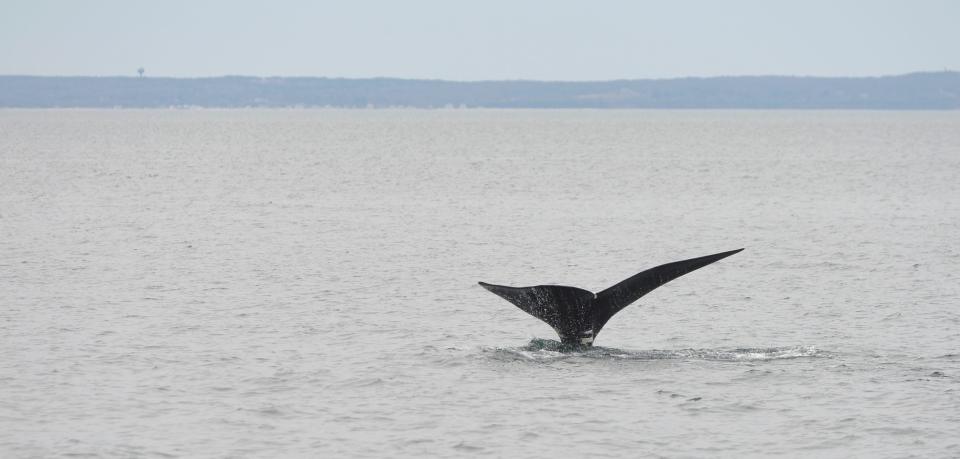How are right whales in Cape Cod Bay studied? A day on the research boat Shearwater
CAPE COD BAY — All eyes were on the water.
From inside the cabin of the research vessel Shearwater, Christy Hudak, a research associate with the Center for Coastal Studies in Provincetown, picked up a pair of binoculars and scanned Cape Cod Bay. Interns Morgan Pirozzi and Shreya Vinodh were doing the same from the higher vantage point atop the cabin.
The center’s right whale ecology team was looking for North Atlantic right whales during a trip on Monday. In January, they had spotted the first of the rare cetaceans for the year in the bay.
The team’s goal is to document what the whales are eating and which individual whales are present. But even what they aren’t eating may be important.

“We’re going to be looking at the plankton and finding out what the right whales are feeding on and what they’re not feeding on,” Hudak said.
The large whales return from their southern winter habitat to feed on tiny prey — calanus, pseudocalanus, and centropages — crustaceans known as copepods, a species of zooplankton.
Plankton nets are deployed to collect samples. Some are dragged behind the boat, following the path of a whale that was skim feeding. A vertical tow is lowered into the water to determine how deep in the water column the food source is.
Early morning departure
The research vessel had left MacMillian Pier in Provincetown earlier in the morning, making its way out of the harbor and around Long Point Light. After finding no whales around the Cape’s sandy tip, the Shearwater cut across the bay to locations where there had been sightings reported earlier. After more than an hour, the crew spotted their first right whale of the day, one of about 19 that were documented during the nearly nine-hour trip.

Researchers document the number of whales, their behavior and if they’re feeding, Pirozzi said. Salinity and water temperature is recorded and photos are taken of the whales.
“I use my photo documentation not only to identify the whales but for our health assessment,” Pirozzi said. “We photograph the whole body, any new scars they may have, whether they look skinny or healthy.”
The whales may have identifying marks and features, whether it’s a scar on its body or the unique pattern of callosities on their head.
How to find a right whale?
Locating the whales can be as simple as seeing them swim by with their mouths open, filter feeding zooplankton just below the water’s surface before they slip back under water, sometimes showing off flukes, or tail, as they dive deeper. They could be located by the sound or the sight of them exhaling through their blowholes. Another sign of whales are the “footprints” left behind by the movement of their flukes that create a circular pattern in the water as they move.

Scientists estimate there are about 356 of these critically endangered whales. By identifying the whales, researchers can track them through their lives. During the 2022-23 season, 198 individual right whales were identified in an around Cape Cod Bay by the Provincetown-based team. This season, the team has observed 123 individual right whales in the bay, according to a statement from the center.
A mother and calf north of Marshfield
For the first time this season, aerial observers from the center on Monday saw a right whale with her calf just north of Marshfield. They were identified as 36-year-old Legato and her daughter, Staccato. The calf was born in December and the two whales were first sighted together New Year’s Eve by Florida’s Fish and Wildlife Research Institute.
“We were just finishing a survey track line when we saw a right whale feeding less than a mile from the beach off North Marshfield,” center aerial observer and right whale researcher Ryan Schosberg said in the statement. “We flew over to document the animal and all cheered in excitement when a little calf popped up by its side! It’s always a relief to see right whale mothers arriving safely in Cape Cod Bay with their calves.”
The right whale team will continue to monitor by boat and plane the migration of the right whales. Most of the sightings happen in March and April. At times, the whales can be seen from shore, particularly on Provincetown’s beaches.
Thanks to our subscribers, who help make this coverage possible. If you are not a subscriber, please consider supporting quality local journalism with a Cape Cod Times subscription. Here are our subscription plans.
This article originally appeared on Cape Cod Times: Right whales make their annual trip to Cape Cod Bay. What to know.

